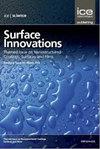Study on the structure and corrosion resistance of micro-arc oxidation coatings on TA10 titanium alloy with different graphite additions
IF 3.5
4区 材料科学
Q3 CHEMISTRY, PHYSICAL
引用次数: 0
Abstract
To improve the corrosion resistance of the Ti–0.3Mo–0.8Ni (TA10) titanium alloy, a micro-arc oxidation coating was prepared on its surface, and the effect of different amounts of graphite addition on the structure and corrosion resistance of the coatings was studied. Through methods such as X-ray diffraction phase analysis, microscopic morphology analysis, roughness analysis, coating thickness analysis and hardness testing, it was found that the added graphite particles can react with silicon (Si) in the electrolyte to promote the formation of the silicon carbide (SiC) phase, thereby improving the surface morphology of the coatings, increasing the thickness of the coatings and improving the microhardness of the coatings. At the same time, dynamic potential polarization curve and scanning electrochemical test results show that the formation of the silicon carbide phase can increase self-corrosion potential and reduce self-corrosion current density. When the amount of graphite added is 1.0 g/l, the self-corrosion potential and self-corrosion current density are −0.129 V and 2.9 × 10 −8 A/cm 2 , respectively. This indicates that adding graphite particles can enhance the corrosion resistance of the TA10 titanium alloy.不同石墨添加量TA10钛合金微弧氧化膜的组织及耐蚀性研究
为了提高Ti-0.3Mo-0.8Ni (TA10)钛合金的耐蚀性,在其表面制备了微弧氧化涂层,研究了石墨添加量对涂层组织和耐蚀性的影响。通过x射线衍射物相分析、微观形貌分析、粗糙度分析、涂层厚度分析和硬度测试等方法发现,添加的石墨颗粒可以与电解液中的硅(Si)发生反应,促进碳化硅(SiC)相的形成,从而改善涂层的表面形貌,增加涂层的厚度,提高涂层的显微硬度。同时,动态电位极化曲线和扫描电化学测试结果表明,碳化硅相的形成可以提高自腐蚀电位,降低自腐蚀电流密度。当石墨添加量为1.0 g/l时,自腐蚀电位为−0.129 V,自腐蚀电流密度为2.9 × 10−8 A/ cm2。这说明石墨颗粒的加入可以提高TA10钛合金的耐腐蚀性。
本文章由计算机程序翻译,如有差异,请以英文原文为准。
求助全文
约1分钟内获得全文
求助全文
来源期刊

Surface Innovations
CHEMISTRY, PHYSICALMATERIALS SCIENCE, COAT-MATERIALS SCIENCE, COATINGS & FILMS
CiteScore
5.80
自引率
22.90%
发文量
66
期刊介绍:
The material innovations on surfaces, combined with understanding and manipulation of physics and chemistry of functional surfaces and coatings, have exploded in the past decade at an incredibly rapid pace.
Superhydrophobicity, superhydrophlicity, self-cleaning, self-healing, anti-fouling, anti-bacterial, etc., have become important fundamental topics of surface science research community driven by curiosity of physics, chemistry, and biology of interaction phenomenon at surfaces and their enormous potential in practical applications. Materials having controlled-functionality surfaces and coatings are important to the manufacturing of new products for environmental control, liquid manipulation, nanotechnological advances, biomedical engineering, pharmacy, biotechnology, and many others, and are part of the most promising technological innovations of the twenty-first century.
 求助内容:
求助内容: 应助结果提醒方式:
应助结果提醒方式:


